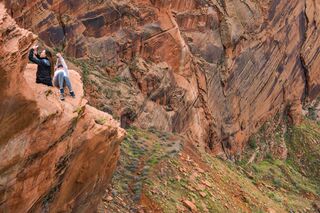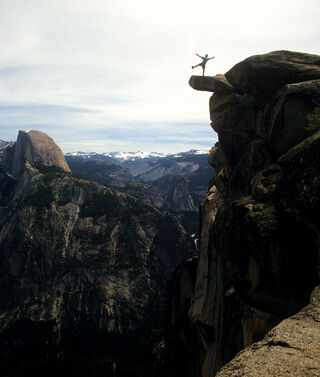Narcissism
How Far Will You Go for the Perfect Instagram Selfie?
Three reasons why thousands pose for outrageous and dangerous selfies each year.
Posted September 28, 2021 Reviewed by Ekua Hagan
Key points
- Motivated by the glory of Instagram and other social media, some users go to dangerous places to outdo the competition.
- Recent research demonstrates that stress responses tied to powerful ancestral fears show up in babies as young as 6 months, but why not everyone?
- Three psychological traits may explain why some are more likely to overlook dangers that are obvious to everyone else.
- Thrill-seekers, narcissists, and those with low levels of anxiety feel less stress in risky positions, allowing them to do what others will not.

“I had goosebumps the whole time she was out on the edge,” one of the onlookers told me after a young woman finally climbed back to a safer spot on the scenic overlook. Another said, “I know the photoshoot is over, but I still feel a little shaky and my anxiety is sky high.”
Glory on the 'Gram: Is It Worth It?
The view from the tippy top of Glacier Point in Yosemite National Park is nothing short of spectacular. Sights include Tenaya Canyon, the Merced River, several waterfalls, and the iconic Half Dome. Towering 3200 feet above Curry Village and the valley below, it is no wonder so many visitors take pictures. Just beyond the solid level ground and reassuring railings of the designated visitors' area is a sizeable piece of rock known as “the diving board." Despite the many well-placed, impossible-to-miss signs warning human beings not to climb over the railing and walk out to the edge of the diving board, many people do.
Fear as an Evolved Emotion
Recent research has found that some of the threats present in our ancestral past (for example, snakes and spiders) can induce stress responses even at the very young age of six months. It is not even necessary for us to have had negative experiences with these creatures to fear them. They are likely embedded in us, thanks to our ancestors' coexistence with them for 40 to 60 million years. Just like spiders and snakes, high places have been around throughout evolutionary history and can trigger a similar state of fear and inhibition. Many of us have a visceral response to standing on the edge of a mountain, but why do some people seem immune to this feeling? Here are three reasons.

1. Thrill-Seeking
Thrill-seekers, or risk-takers, sometimes crave activities that have an element of physical danger or risk of being caught doing something illegal or malicious. Because these "sensation seekers" have little concern for their own safety or the safety of others, they will try to convince people around them to engage in risky behavior. In some contexts, this may seem fun, until it becomes clear to others that this goes beyond what is normally acceptable. For example, “I’m so bored. We should all get in my car and play chicken with other cars tonight out on the road.” Or, “Let’s see how far you can drive down this dark road with your headlights off.”
This problem is not unique to Yosemite. From the most popular national parks down to less crowded local state parks, more and more people are taking real risks to get a unique photo they can post on social media. Data from a website that tracks selfie-related incidents at some of the world's most Instagrammable holiday destinations placed Yosemite and The Grand Canyon as the top two destinations where travelers routinely risk it all for glory on the 'gram and this trend will likely continue. Since 1851, Yosemite has recorded over 1500 accidental deaths. On average, the park sees 5 million visitors each year and millions of tourists post their Yosemite pics on Instagram.
2. Narcissistic Tendencies
There is a difference between a clinical narcissist—someone who meets diagnostic criteria in the DSM—and those with narcissistic tendencies, or sub-clinical narcissists. Just because you take pictures of yourself and post them for public consumption does not mean you have narcissistic personality disorder. However, there are many people who have narcissistic traits or tendencies without meeting diagnostic criteria. For example, they may show confidence to the point that it borders on arrogance, even where it is not justified: “Even though I’ve never done this before, I’m sure no one can do it better than me.”
There is an inflated sense of importance and competitiveness motivating behavior that becomes the driving force behind attaining positions of power, fame, and status. In some cases, they have distorted views about their potential and have trouble seeing themselves and their talents the way others do. This type of grandiosity leads narcissists to believe that normal safety rules and customs do not apply to them. This can be a dangerous state of mind for someone perched next to a cliff with a selfie stick in one hand.
3. Low Anxiety
How are spiders, snakes, and heights different from ionizing radiation, semi-automatic weapons, and chainsaws? The first ones are classified as ancestral threats because they have been around since the beginning of human history. The newer, sophisticated, beautiful, fast-paced, and sometimes dangerous world we inhabit now began about 10,000 years ago with the advent of agriculture. Modern threats—the second set of items above—belong to this more recent era.
Throughout human evolution, the ability to identify threatening situations has been a critical feature of our psychological structure. A failure to recognize and thwart a threat could have been fatal for our ancestors. In contrast, the primary threats to most people today, especially in modern urban settings, are different than the environmental threats dominant up until a few centuries ago. We now increasingly face threats that are substantively different, more technical, and in some ways less tangible.
A moderate amount of anxiety is a good thing. Especially if you are 2,000 feet up on a windy day with a mobile device in your hands. People with very low levels of anxiety have psychological danger detectors that are calibrated differently from the rest of us. Ancestral threats like snakes, spiders, and heights don't bother them any more than modern dangers such as fast-moving automobile traffic, firearms, razor blades weaponized, nanotechnology, pollution, fried foods, alcohol, drug overdoses, decompression, power drills, and helicopters. "We are all going to die from something," says your no-stress, low-anxiety friend.
©2021 Kevin Bennett Ph.D. All rights reserved.
References
Bennett, K. (2019). Ancestral threats vs. modern threats. In Shackelford, T.K., & Weekes‐Shackelford, V. (Eds.), Encyclopedia of Evolutionary Psychological Science. Springer, Cham. https://doi.org/10.1007/978-3-319-16999-6_2997-1
Bennett, K. (2018). Environment of evolutionary adaptedness (EEA). In Zeigler-Hill, V., & Shackelford, T.K. (Eds.), Encyclopedia of Personality and Individual Differences. Springer International Publishing AG. https://doi.org/10.1007/978-3-319-28099-8_1627-1
Hoehl, S., Hellmer, K., Johansson, M., & Gredebäck, G. (2017). Itsy bitsy spider…:Infants react with increased arousal to spiders and snakes. Frontiers in Psychology, 8, 1710. doi:10.3389/fpsyg.2017.01710




